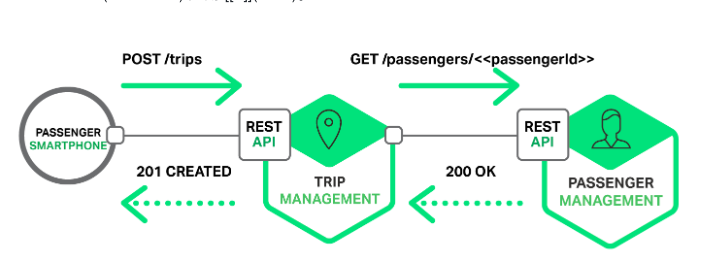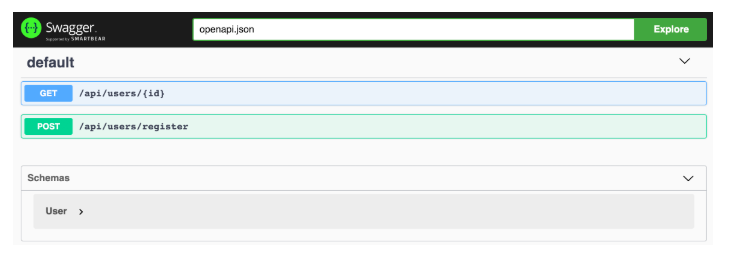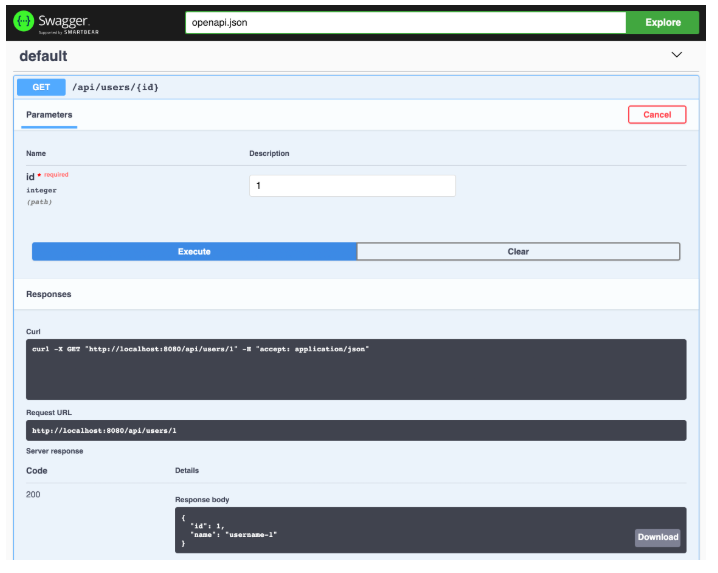什么是 REST
REST 是 Roy Thomas Fielding [[1]](#fn1) 在 2000 年他的博士论文 [[2]](#fn2) “架构风格以及基于网络的软件架构设计” 中提出来的一个概念。REST 是 RESTransfer 的缩写,翻译过来就是 “表现层状态转化”。REST 就是 Roy 在这篇论文中提出的面向互联网的软件所应当具备的架构风格。
按照 REpresentational State Transfer 的字面意思,可以把应用看成是一个虚拟的状态机,软件提供的不是服务而是一系列的资源统一的操作**来访问,而返回的结果代表了资源状态的一次跃迁。REST 是一种架构风格,如果一个软件架构符合 REST 风格,就可以称之为 RESTful 架构。这个架构应当具备以下一些设计上的约束:资源具有唯一标示、资源之间有关联关系、使用标准的方式来访问、资源有多种表现形式、无状态交互。
举例来说,一个简单的静态 HTML 页面的网站就很好的符合了 RESTful 架构风格。访问 http://acme.com/accounts 返回一个包含所有账号的页面,选取其中一个链接 http://acme.com/accounts/1 又会返回包含用户 1 的详细信息。爬虫软件在这种场景下工作的很好,当知道了某个网站的首页地址后,可以自举发现这个网站上所有关联的网页。更重要的是,这种访问形式不依赖网站提供的任何客户端,而是仅仅通过 HTTP 标准的访问方式完成的。可以说,HTML 这种超媒体文档的组织形式就是资源的表现层状态迁移的一种形式。
对于一个提供服务的动态网站来说,可以按照类似的思路将其 RESTful 化:
- GET http://acme.com/accounts 返回所有账号信息
- POST http://acme.com/accounts 创建一个新的账号
- GET http://acme.com/accounts/1 返回账号 1 的信息
- DELETE http://acme.com/accounts/1 删除账号 1
- PUT http://acme.com/accounts/1 更新账号 1 信息
其中的思路是利用 HTTP 协议的标准方法 POST、DELETE、PUT、GET 来表达对于一个资源的增删改查 (CRUD) 操作,利用 URL 来表示一个资源的唯一标识。对资源访问的错误码也复用 HTTP 协议的状态码。返回结果通常由 json 或 XML 来表示,如果其中包换了对关联资源的访问方式 (所谓的表现层状态迁移) ,这种类型的 RESTful 应用可以进一步的称之为 hypermedia as the engine of application state (HATEOAS) 应用 [[3]](#fn3)。

source: https://www.nginx.com/wp-content/uploads/2016/04/micro-image.png
这里需要注意的是,按照 Roy 的定义,RESTful 架构风格与 HTTP 协议并没有什么强关联关系。但是,基于 HTTP 的 RESTful 架构风格是实现起来最自然,也是目前使用最广泛的一种实现,我们称之为 RESTful HTTP。同样的,在下文中将会专注在 HTTP 的场景下介绍如何在 Dubbo 框架中将服务暴露成 Restful 架构。
在 Dubbo 中使用 REST
背景
随着微服务的流行以及多语言互操作诉求日益增多,在 Dubbo 中暴露 REST 服务变成了一个不容忽视的诉求。为了在 Dubbo 中暴露 REST 服务,通常有两种做法,一种是直接依赖 Sprng REST 或者其他 REST 框架来直接暴露,另一种是通过 Dubbo 框架内置的 REST 能力暴露。两种做法各有优缺点,主要体现在前者与微服务体系中的服务发现组件能够更好的工作,而后者可以无缝的享受到 Dubbo 体系中的服务发现以及服务治理的能力。本文关注的是如何使用后者来暴露 REST 服务。
自 2.6.0 开始,Dubbo 合并了当当网捐献的 DubboX [[4]](#fn4) 中的主要特性,其中就包括了基于 RESTeasy 3.0.19.Final 的 REST 支持,具备 JAXRS 2.0 规范中所有的能力。
基本用法
在以下的例子中,展示了如何通过最传统的 Spring XML 配置的方式来快速的暴露和调用一个 REST 服务。其中底层的 server 使用的是 netty,服务注册发现基于 Zookeeper。
注:本章节讨论的示例可以通过 https://github.com/beiwei30/dubbo-rest-samples/tree/master/basic 来获得
1. Maven 依赖
首先需要在项目中引入 dubbo all-in-one 的依赖以及 RESTEasy 相关的必要依赖。因为在本例中使用 Zookeeper 作为服务发现,还需要引入 Zookeeper client 相关的依赖。为了方便使用,第三方的依赖可以通过框架提供的 BOM 文件 dubbo-dependencies-bom 来引入。
<properties>
<dubbo.version>2.6.5</dubbo.version>
</properties>
<dependencyManagement>
<dependencies>
<dependency>
<groupId>com.alibaba</groupId>
<artifactId>dubbo-dependencies-bom</artifactId>
<version>${dubbo.version}</version>
<type>pom</type>
<scope>import</scope>
</dependency>
</dependencies>
</dependencyManagement>
<dependencies>
<dependency>
<groupId>com.alibaba</groupId>
<artifactId>dubbo</artifactId>
<version>${dubbo.version}</version>
</dependency>
<!-- REST support dependencies -->
<dependency>
<groupId>io.netty</groupId>
<artifactId>netty-all</artifactId>
</dependency>
<dependency>
<groupId>org.jboss.resteasy</groupId>
<artifactId>resteasy-jaxrs</artifactId>
</dependency>
<dependency>
<groupId>org.jboss.resteasy</groupId>
<artifactId>resteasy-client</artifactId>
</dependency>
<dependency>
<groupId>org.jboss.resteasy</groupId>
<artifactId>resteasy-netty4</artifactId>
</dependency>
<dependency>
<groupId>javax.validation</groupId>
<artifactId>validation-api</artifactId>
</dependency>
<dependency>
<groupId>org.jboss.resteasy</groupId>
<artifactId>resteasy-jackson-provider</artifactId>
</dependency>
<dependency>
<groupId>org.jboss.resteasy</groupId>
<artifactId>resteasy-jaxb-provider</artifactId>
</dependency>
<dependency>
<groupId>javax.servlet</groupId>
<artifactId>javax.servlet-api</artifactId>
</dependency>
<!-- zookeeper client dependency -->
<dependency>
<groupId>org.apache.curator</groupId>
<artifactId>curator-framework</artifactId>
</dependency>
</dependencies>2. 定义服务接口
定义一个服务接口 UserService,该接口提供两个功能,一个是获取指定 User 的详细信息,另一个是新注册一个用户。
@Path("users") // #1
@Consumes({MediaType.APPLICATION_JSON, MediaType.TEXT_XML}) // #2
@Produces({MediaType.APPLICATION_JSON, MediaType.TEXT_XML})
public interface UserService {
@GET // #3
@Path("{id: \d+}")
User getUser(@PathParam("id") Long id);
@POST // #4
@Path("register")
Long registerUser(User user);
}通过在接口上用 JaxRS 标准的 annotation 来修饰,我们规定了该服务在 REST 下的访问形式:
@Path("users")定义了 UserService 通过 '/users' 来访问- 在类级别上定义
@Consumers和@Produces来规定参数以及返回值的类型为 XML 和 JSON。在类级别上定义之后,就可以不用在方法级别上进一步定义了 - getUser 方法上通过
@GET定义了接受的 HTTP 方法为 GET,通过@Path来规定参数是来自于 URL 中的 path。'GET /users/1' 等同于调用 'getUser(1)' - registerUser 方法上通过
@POST定义了接受的 HTTP 方法为 POST,通过将 JSON 或 XML 格式的 User 数据 POST 到 '/users/register' 上来创建一个 User
在 Dubbo 中,将 REST 相关的 annotation 定义在接口或者实现上都是可以的。这个在设计上是个权衡问题。Annotation 定义在实现类上可以保证接口的纯净,否则对于不需要通过 REST 方式调用的 Dubbo 调用方来说将需要强制依赖 JaxRS 的库,但是同时,对于需要通过 REST 方式调用的 Dubbo 调用方来说,就需要自己来处理 REST 调用相关的细节了。Annotation 定义在接口上,框架会自动处理掉 REST 调用相关的细节,并和 Dubbo 的服务发现以及服务治理功能能够很好的结合起来。在本例中采用了在接口上定义 JaxRS annotation 的形式。
3. 实现服务接口
为了简洁,这里给出的接口的实现只是简单的返回了接口需要的类型的示例,在真实的系统中,逻辑可能会比较复杂。
public class UserServiceImpl implements UserService {
private final AtomicLong id = new AtomicLong();
public User getUser(Long id) {
return new User(id, "username-" + id);
}
public Long registerUser(User user) {
return id.incrementAndGet();
}
}4. 装配服务
如上所述,本例展示的是如何通过传统的 Spring XML 的方式来装配并暴露 Dubbo 服务。需要指出的是,这里展示了如何同时暴露两种不同的协议,一种是 REST,另一种是原生的 Dubbo 协议。
<?xml version="1.0" encoding="UTF-8"?>
<beans xmlns="http://www.springframework.org/schema/beans"
xmlns:xsi="http://www.w3.org/2001/XMLSchema-instance"
xmlns:dubbo="http://code.alibabatech.com/schema/dubbo"
xsi:schemaLocation="http://www.springframework.org/schema/beans http://www.springframework.org/schema/beans/spring-beans.xsd http://code.alibabatech.com/schema/dubbo http://code.alibabatech.com/schema/dubbo/dubbo.xsd">
<dubbo:application name="rest-provider"/> <!-- #1 -->
<dubbo:registry address="zookeeper://127.0.0.1:2181"/> <!-- #2 -->
<dubbo:protocol name="rest" port="8080" server="netty"/> <!-- #3 -->
<dubbo:protocol name="dubbo" server="netty4"/> <!-- #4 -->
<dubbo:service interface="org.apache.dubbo.samples.rest.api.UserService" protocol="rest,dubbo" ref="userService"/> <!-- #5 -->
<bean id="userService" class="org.apache.dubbo.samples.rest.impl.UserServiceImpl"/>
</beans> <!-- #6 -->- 定义了该应用的名字为
rest-provider - 定义了服务注册通过 Zookeeper,并且 URL 为 "zookeeper://127.0.0.1:2181"
- 在端口 8080 上以 REST 方式暴露服务,底层的传输使用的是 netty
- 在默认端口 20880 上以原生 Dubbo 方式暴露服务,底层的传输方式是 netty
- 将 ‘userService' 的 Spring bean (也就是 UserServiceImpl)暴露为 UserService 服务,支持的协议既包括了 REST 也包括了 Dubbo
- 将 UserServiceImpl 注册成 'userService' 的 Spring bean
5. 服务提供方的启动类
简单的通过 ClassPathXmlApplicationContext 来加载刚刚配置的 Spring XML 配置 'rest-provider.xml' 即可启动 Dubbo 服务端
public class RestProvider {
public static void main(String[] args) throws IOException {
ClassPathXmlApplicationContext context = new ClassPathXmlApplicationContext("spring/rest-provider.xml");
context.start();
System.in.read();
}
}6. 启动服务端
由于本例依赖 Zookeeper 做服务注册发现,在启动 RestProvider 之前,需要先启动一个 Zookeeper 服务器。之后就可以直接运行 RestProvider 了。通过以下的输出日志,我们可以知道 UserService 以两种方式对外暴露了同一个服务,其中:
- REST: rest://192.168.2.132:8080/org.apache.dubbo.samples.rest.api.UserService
- Dubbo: dubbo://192.168.2.132:20880/org.apache.dubbo.samples.rest.api.UserService
...
[01/01/19 07:18:56:056 CST] main INFO config.AbstractConfig: [DUBBO] Export dubbo service org.apache.dubbo.samples.rest.api.UserService to url rest://192.168.2.132:8080/org.apache.dubbo.samples.rest.api.UserService?anyhost=true&application=rest-provider&bean.name=org.apache.dubbo.samples.rest.api.UserService&bind.ip=192.168.2.132&bind.port=8080&dubbo=2.0.2&generic=false&interface=org.apache.dubbo.samples.rest.api.UserService&methods=getUser,registerUser&pid=27386&server=netty&side=provider×tamp=1546341536194, dubbo version: 2.6.5, current host: 192.168.2.132
...
[01/01/19 07:18:57:057 CST] main INFO config.AbstractConfig: [DUBBO] Export dubbo service org.apache.dubbo.samples.rest.api.UserService to url dubbo://192.168.2.132:20880/org.apache.dubbo.samples.rest.api.UserService?anyhost=true&application=rest-provider&bean.name=org.apache.dubbo.samples.rest.api.UserService&bind.ip=192.168.2.132&bind.port=20880&dubbo=2.0.2&generic=false&interface=org.apache.dubbo.samples.rest.api.UserService&methods=getUser,registerUser&pid=27386&server=netty4&side=provider×tamp=1546341537392, dubbo version: 2.6.5, current host: 192.168.2.132
...也可以通过 zkCli 访问 Zookeeper 服务器来验证。'/dubbo/org.apache.dubbo.samples.rest.api.UserService/providers' 路径下返回了一个数组 [dubbo://..., rest:.//...]。数组的第一个元素是 ’dubbo‘ 打头的,而第二个元素是 'rest' 打头的。
[zk: localhost:2181(CONNECTED) 10] ls /dubbo/org.apache.dubbo.samples.rest.api.UserService/providers
[dubbo%3A%2F%2F192.168.2.132%3A20880%2Forg.apache.dubbo.samples.rest.api.UserService%3Fanyhost%3Dtrue%26application%3Drest-provider%26bean.name%3Dorg.apache.dubbo.samples.rest.api.UserService%26dubbo%3D2.0.2%26generic%3Dfalse%26interface%3Dorg.apache.dubbo.samples.rest.api.UserService%26methods%3DgetUser%2CregisterUser%26pid%3D27386%26server%3Dnetty4%26side%3Dprovider%26timestamp%3D1546341537392, rest%3A%2F%2F192.168.2.132%3A8080%2Forg.apache.dubbo.samples.rest.api.UserService%3Fanyhost%3Dtrue%26application%3Drest-provider%26bean.name%3Dorg.apache.dubbo.samples.rest.api.UserService%26dubbo%3D2.0.2%26generic%3Dfalse%26interface%3Dorg.apache.dubbo.samples.rest.api.UserService%26methods%3DgetUser%2CregisterUser%26pid%3D27386%26server%3Dnetty%26side%3Dprovider%26timestamp%3D1546341536194]可以简单的通过 'curl' 在命令行验证刚才暴露出来的 REST 服务:
$ curl http://localhost:8080/users/1
{"id":1,"name":"username-1"}
$ curl -X POST -H "Content-Type: application/json" -d '{"id":1,"name":"Larry Page"}' http://localhost:8080/users/register
17. 装配调用端
Dubbo 调用方只需要依赖服务的接口,通过以下方式装配好 Dubbo Consumer,即可发起调用。
<?xml version="1.0" encoding="UTF-8"?>
<beans xmlns="http://www.springframework.org/schema/beans"
xmlns:xsi="http://www.w3.org/2001/XMLSchema-instance"
xmlns:dubbo="http://code.alibabatech.com/schema/dubbo"
xsi:schemaLocation="http://www.springframework.org/schema/beans http://www.springframework.org/schema/beans/spring-beans.xsd http://code.alibabatech.com/schema/dubbo http://code.alibabatech.com/schema/dubbo/dubbo.xsd">
<dubbo:application name="rest-consumer"/>
<dubbo:registry address="zookeeper://127.0.0.1:2181"/>
<dubbo:reference id="userService" interface="org.apache.dubbo.samples.rest.api.UserService" protocol="rest"/> <!-- #1 -->
</beans>- 'userService' 配置的 protocol 为 “rest",将通过 REST 协议调用服务端
需要特别指出的是,这里显示的指定 protocol="rest" 在通常情况下不是必须的。这里需要显示指定的原因是我们例子中服务端同时暴露了多种协议,这里指定使用 rest 是为了确保调用方走 REST 协议。
8. 发起调用
简单的通过 ClassPathXmlApplicationContext 来加载刚刚配置的 Spring XML 配置 'rest-consumer.xml' 即可发起对 RestProvider 所提供的 UserService 的 REST 服务的调用。
public class RestConsumer {
public static void main(String[] args) {
ClassPathXmlApplicationContext context = new ClassPathXmlApplicationContext("spring/rest-consumer.xml");
context.start();
UserService userService = context.getBean("userService", UserService.class);
System.out.println(">>> " + userService.getUser(1L));
User user = new User(2L, "Larry Page");
System.out.println(">>> " + userService.registerUser(user));
}
}这里分别展示了对 'getUser' 和 'registerUser' 的调用,输出结果如下:
>>> User{id=1, name='username-1'}
>>> 2进阶
A. 在 REST 中使用 Annotation
在 Dubbo 中使用 annotation 而不是 Spring XML 来暴露和引用服务,对于 REST 协议来说并没有什么不同。有关如何使用 annotation 更详细的用法,请参阅《在 Dubbo 中使用注解》章节。这里主要展示一下与上面基于 Spring XML 配置的例子不同之处。
注:本章节讨论的示例可以通过 https://github.com/beiwei30/dubbo-rest-samples/tree/master/annotation 来获得
1. 使用 Java Configuration 来配置服务提供方的 protocol、registry、application
@Configuration
@EnableDubbo(scanBasePackages = "org.apache.dubbo.samples.rest.impl") // #1
static class ProviderConfiguration {
@Bean // #2
public ProtocolConfig protocolConfig() {
ProtocolConfig protocolConfig = new ProtocolConfig();
protocolConfig.setName("rest");
protocolConfig.setPort(8080);
protocolConfig.setServer("netty");
return protocolConfig;
}
@Bean // #3
public RegistryConfig registryConfig() {
RegistryConfig registryConfig = new RegistryConfig();
registryConfig.setProtocol("zookeeper");
registryConfig.setAddress("localhost");
registryConfig.setPort(2181);
return registryConfig;
}
@Bean
public ApplicationConfig applicationConfig() {
ApplicationConfig applicationConfig = new ApplicationConfig();
applicationConfig.setName("rest-provider");
return applicationConfig;
}
}- 通过
@EnableDubbo来指定需要扫描 Dubbo 服务的包名,在本例中,UserServiceImpl 在 "org.apache.dubbo.samples.rest.impl" 下 - 通过提供一个 ProtocolConfig 的 Spring Bean 来指定服务提供方按照 REST 来暴露服务
- 通过提供一个 RegistryConfig 的 Spring Bean 来指定服务提供方所使用的服务注册机制
2. 使用 Service 来申明 Dubbo 服务
@Service // #1
public class UserServiceImpl implements UserService {
...
}- 简单的使用
@Service或者@Service(protocol = "rest")修饰 "UserServiceImpl" 来申明一个 Dubbo 服务,这里protocol = "rest"不是必须提供的,原因是通过 Java Configuration 只配置了一个 ProtocolConfig 的示例,在这种情况下,Dubbo 会自动装配该协议到服务中
3. 服务提供方启动类
通过使用 ProviderConfiguration 来初始化一个 AnnotationConfigApplicationContext 实例,就可以完全摆脱 Spring XML 的配置文件,完全借助 annotation 来装配好一个 Dubbo 的服务提供方。
public class RestProvider {
public static void main(String[] args) throws IOException {
AnnotationConfigApplicationContext context = new AnnotationConfigApplicationContext(ProviderConfiguration.class);
context.start();
System.in.read();
}
}4. 使用 Java Configuration 来配置服务消费方的 registry、application
@Configuration
@EnableDubbo(scanBasePackages = "org.apache.dubbo.samples.rest.comp") // #1
@ComponentScan({"org.apache.dubbo.samples.rest.comp"}) // #2
static class ConsumerConfiguration {
@Bean // #3
public RegistryConfig registryConfig() {
RegistryConfig registryConfig = new RegistryConfig();
registryConfig.setProtocol("zookeeper");
registryConfig.setAddress("localhost");
registryConfig.setPort(2181);
return registryConfig;
}
@Bean
public ApplicationConfig applicationConfig() {
ApplicationConfig applicationConfig = new ApplicationConfig();
applicationConfig.setName("rest-consumer");
return applicationConfig;
}
}- 通过
@EnableDubbo来指定需要扫描 Dubbo 服务引用@Reference的包名。在本例中,UserService 的引用在 "org.apache.dubbo.samples.rest.comp" 下 - 通过
@ComponentScan来指定需要扫描的 Spring Bean 的包名。在本例中,包含 UserService 引用的类 UserServiceComponent 本身需要是一个 Spring Bean,以方便调用,所以,这里指定的包名也是 "org.apache.dubbo.samples.rest.comp" - 通过提供一个 RegistryConfig 的 Spring Bean 来指定服务消费方所使用的服务发现机制
这里提到的 UserServiceComponent 的 Spring Bean 定义如下:
@Component
public class UserServiceComponent implements UserService { // #1
@Reference
private UserService userService;
@Override
public User getUser(Long id) {
return userService.getUser(id);
}
@Override
public Long registerUser(User user) {
return userService.registerUser(user);
}
}- 这里比较好的实践是让这个 Spring Bean 也继承
UserService接口,这样在调用的时候也可以面向接口编程
5. 服务调用方启动类
通过使用 ConsumerConfiguration 来初始化一个 AnnotationConfigApplicationContext 实例,就可以完全摆脱 Spring XML 的配置文件,完全借助 annotation 来装配好一个 Dubbo 的服务消费方。然后就可以通过查找 UserServiceComponent 类型的 Spring Bean 来发起远程调用。
public class RestConsumer {
public static void main(String[] args) {
AnnotationConfigApplicationContext context = new AnnotationConfigApplicationContext(ConsumerConfiguration.class);
context.start();
UserService userService = context.getBean(UserServiceComponent.class);
System.out.println(">>> " + userService.getUser(1L));
User user = new User(2L, "Larry Page");
System.out.println(">>> " + userService.registerUser(user));
}
}B. 让协议跑在不同的服务器上
目前 REST 协议在 Dubbo 中可以跑在五种不同的 server 上,分别是:
- "netty": 直接基于 netty 框架的 rest server,通过
<dubbo:protocol name="rest" server="netty"/>来配置 - "tomcat": 基于嵌入式 tomcat 的 rest server,通过
<dubbo:protocol name="rest" server="tomcat"/>来配置 - "jetty": 默认选项,基于嵌入式 jetty 的 rest server,通过
<dubbo:protocol name="rest" server="jetty"/>来配置 - "sunhttp": 使用 JDK 内置的 Sun HTTP server 作为 rest server,通过
<dubbo:protocol name="rest" server="sunhttp"/>来配置,仅推荐在开发环境中使用 - "servlet”: 采用外部应用服务器的 servlet 容器来做 rest server,这个时候,除了配置
<dubbo:protocol name="rest" server="servlet"/>之外,还需要在 web.xml 中做额外的配置
由于以上的例子展示了 "netty" 作为 rest server,下面演示一下使用嵌入式 tomcat 的 rest server 的用法。
注:本章节讨论的示例可以通过 https://github.com/beiwei30/dubbo-rest-samples/tree/master/tomcat 来获得
1. 增加 Tomcat 相关的依赖
<dependency>
<groupId>org.apache.tomcat.embed</groupId>
<artifactId>tomcat-embed-core</artifactId>
</dependency>
<dependency>
<groupId>org.apache.tomcat.embed</groupId>
<artifactId>tomcat-embed-logging-juli</artifactId>
</dependency>2. 配置 protocol 使用 tomcat 作为 REST server
<dubbo:protocol name="rest" port="8080" server="tomcat"/>启动服务提供方之后,在以下的输出将会出现与嵌入式 Tomcat 相关的日志信息:
Jan 01, 2019 10:15:12 PM org.apache.catalina.core.StandardContext setPath
WARNING: A context path must either be an empty string or start with a '/' and do not end with a '/'. The path [/] does not meet these criteria and has been changed to []
Jan 01, 2019 10:15:13 PM org.apache.coyote.AbstractProtocol init
INFO: Initializing ProtocolHandler ["http-nio-8080"]
Jan 01, 2019 10:15:13 PM org.apache.tomcat.util.net.NioSelectorPool getSharedSelector
INFO: Using a shared selector for servlet write/read
Jan 01, 2019 10:15:13 PM org.apache.catalina.core.StandardService startInternal
INFO: Starting service [Tomcat]
Jan 01, 2019 10:15:13 PM org.apache.catalina.core.StandardEngine startInternal
INFO: Starting Servlet Engine: Apache Tomcat/8.5.31
Jan 01, 2019 10:15:13 PM org.apache.coyote.AbstractProtocol start
INFO: Starting ProtocolHandler ["http-nio-8080"]C. 使用外部的 Servlet 容器
进一步的,还可以使用外部的 servlet 容器来启动 Dubbo 的 REST 服务。
注:本章节讨论的示例可以通过 https://github.com/beiwei30/dubbo-rest-samples/tree/master/servlet 来获得
1. 修改 pom.xml 改变打包方式
因为使用的是外部的 servlet 容器,需要将打包方式修改为 "war"
<packaging>war</packaging>2. 修改 rest-provider.xml
配置 "server" 为 "servlet" 表示将使用外部的 servlet 容器。并配置 "contextpath" 为 "",原因是在使用外部 servlet 容器时,Dubbo 的 REST 支持需要知道被托管的 webapp 的 contextpath 是什么。这里我们计划通过 root context path 来部署应用,所以配置其为 ""。
<dubbo:protocol name="rest" port="8080" server="servlet" contextpath=""/>3. 配置 WEB-INF/web.xml
<?xml version="1.0" encoding="UTF-8"?>
<web-app xmlns="http://xmlns.jcp.org/xml/ns/javaee"
xmlns:xsi="http://www.w3.org/2001/XMLSchema-instance"
xsi:schemaLocation="http://xmlns.jcp.org/xml/ns/javaee http://xmlns.jcp.org/xml/ns/javaee/web-app_3_1.xsd"
version="3.1">
<context-param> <!-- #1 -->
<param-name>contextConfigLocation</param-name>
<param-value>/WEB-INF/classes/spring/rest-provider.xml</param-value>
</context-param>
<listener>
<listener-class>com.alibaba.dubbo.remoting.http.servlet.BootstrapListener</listener-class>
</listener>
<listener>
<listener-class>org.springframework.web.context.ContextLoaderListener</listener-class>
</listener>
<servlet> <!-- #2 -->
<servlet-name>dispatcher</servlet-name>
<servlet-class>com.alibaba.dubbo.remoting.http.servlet.DispatcherServlet</servlet-class>
<load-on-startup>1</load-on-startup>
</servlet>
<servlet-mapping>
<servlet-name>dispatcher</servlet-name>
<url-pattern>/api/*</url-pattern>
</servlet-mapping>- 配置 Dubbo 和 Spring 相关的 ContextListener,打开 Dubbo HTTP 支持,以及通过 rest-provider.xml 来装配 Dubbo 服务
- 配置 Dubbo HTTP 所需的 DispatcherServlet
这样做之后,不再需要 RestProvider 来启动 Dubbo 服务,可以将其从工程中删掉。对应的,现在 Dubbo 的服务将会随着 Servlet 容器的启动而启动。启动完毕之后,可以通过类似 "http://localhost:8080/api/users/1" 来访问暴露出的 REST 服务。需要注意的是,这个例子里假定了服务提供方的 WAR 包部署在 root context path 上,所以当该应用通过 IDE 配置的 tomcat server 启动时,需要指定 Application Context 为 "/"。
D. 增加 Swagger 支持
在上面使用外部 Servlet 容器的例子的基础上,讨论如何暴露 Swagger OpenApi 以及如何继承 Swagger UI。
注:本章节讨论的示例可以通过 https://github.com/beiwei30/dubbo-rest-samples/tree/master/servlet 来获得
1. 暴露 Swagger OpenApi
增加 swagger 相关依赖,以便通过 "http://localhost:8080/openapi.json" 来访问 REST 服务的描述
<properties>
<swagger.version>2.0.6</swagger.version>
</properties>
<dependencies>
<dependency>
<groupId>io.swagger.core.v3</groupId>
<artifactId>swagger-jaxrs2</artifactId>
<version>${swagger.version}</version>
</dependency>
<dependency>
<groupId>io.swagger.core.v3</groupId>
<artifactId>swagger-jaxrs2-servlet-initializer</artifactId>
<version>${swagger.version}</version>
</dependency>
</dependencies>修改 WEB-INF/web.xml,增加 openapi servlet 的配置
<web-app>
...
<servlet> <!-- #3 -->
<servlet-name>openapi</servlet-name>
<servlet-class>io.swagger.v3.jaxrs2.integration.OpenApiServlet</servlet-class>
</servlet>
<servlet-mapping>
<servlet-name>openapi</servlet-name>
<url-pattern>/openapi.json</url-pattern>
<url-pattern>/openapi.yaml</url-pattern>
</servlet-mapping>
</web-app>重新启动应用之后,可以通过访问 "http://localhost:8080/openapi.json" 或者 "http://localhost:8080/openapi.yaml" 来访问暴露出的 openapi 的契约,以下是 yaml 格式的表述:
openapi: 3.0.1
paths:
/api/users/{id}:
get:
operationId: getUser
parameters:
- name: id
in: path
required: true
schema:
type: integer
format: int64
responses:
default:
description: default response
content:
application/json:
schema:
$ref: '#/components/schemas/User'
text/xml:
schema:
$ref: '#/components/schemas/User'
/api/users/register:
post:
operationId: registerUser
requestBody:
description: a user to register
content:
application/json:
schema:
$ref: '#/components/schemas/User'
text/xml:
schema:
$ref: '#/components/schemas/User'
responses:
default:
description: default response
content:
application/json:
schema:
type: integer
format: int64
text/xml:
schema:
type: integer
format: int64
components:
schemas:
User:
type: object
properties:
id:
type: integer
format: int64
name:
type: string2. 集成 Swagger UI
在 pom.xml 中继续增加 swagger-ui 的依赖,这里使用的是 webjars 的版本,从集成的角度来说更加简洁。webjars 的工作机制可以参阅 webjars 官网 [[5]](#fn5)
<properties>
<swagger.webjar.version>3.20.3</swagger.webjar.version>
</properties>
<dependencies>
<dependency>
<groupId>org.webjars</groupId>
<artifactId>swagger-ui</artifactId>
<version>${swagger.webjar.version}</version>
</dependency>
</dependencies>在工程的 webapp/WEB-INF 根目录下增加一个 HTML 文件,内容如下。HTML 文件名可以为任何名字,没有硬性要求,如果该文件被命名为 "swagger-ui.html",那么你可以通过访问 “http://localhost:8080/swagger-ui.html" 来访问 swagger UI。本例为了演示方便起见,将其命名为 "index.html",这样当访问 "http://localhost:8080" 时,就可以很方便的得到 swagger UI 的页面。
<!DOCTYPE html>
<html lang="en">
<head>
<meta charset="UTF-8">
<title>API UI</title>
<link rel="stylesheet" type="text/css" href="webjars/swagger-ui/3.20.3/swagger-ui.css" >
<link rel="icon" type="image/png" href="webjars/swagger-ui/3.20.3/favicon-32x32.png" sizes="32x32" />
<link rel="icon" type="image/png" href="webjars/swagger-ui/3.20.3/favicon-16x16.png" sizes="16x16" />
<style>
html
{
box-sizing: border-box;
overflow: -moz-scrollbars-vertical;
overflow-y: scroll;
}
*,
*:before,
*:after
{
box-sizing: inherit;
}
body
{
margin:0;
background: #fafafa;
}
</style>
</head>
<body>
<div id="swagger-ui"></div>
<script src="webjars/swagger-ui/3.20.3/swagger-ui-bundle.js"> </script>
<script src="webjars/swagger-ui/3.20.3/swagger-ui-standalone-preset.js"> </script>
<script>
window.onload = function () {
window.ui = SwaggerUIBundle({
url: "openapi.json",
dom_id: '#swagger-ui',
deepLinking: true,
presets: [
SwaggerUIBundle.presets.apis,
SwaggerUIStandalonePreset
],
plugins: [
SwaggerUIBundle.plugins.DownloadUrl
],
layout: "StandaloneLayout"
});
};
</script>
</body>
</html>再次重启服务器,并访问 "http://localhost:8080" 时,将会看到 swagger UI 页面的展示:

通过 Swagger UI 可以很方便的浏览当前服务器提供的 REST 服务的文档信息,甚至可以直接调用来做服务测试。以 '/api/users/{id}' 为例,测试结果如下图所示:

总结
本文主要关注了在 Dubbo 中支持 REST 协议的情况。首先探索了 REST 概念的起源,澄清了 REST 是一种适合互联网的软件架构风格,进一步的说明了 REST 风格的架构可以与 HTTP 协议无关,但是 HTTP 协议的确是 REST 风格架构的最常用甚至是最佳的组合和搭档。然后讨论了如何在 Dubbo 中开发 REST HTTP 的几种典型用法,其中包括了通过不同的配置,如传统的 Spring XML,完全通过 annotation 来配置两种典型的用法,本文中没有涉及到的还有纯 API 编程方式,Spring Boot 配置方式也是完全可以的,因为篇幅原因没有提及;还讨论了如何通过不同的 REST server 来暴露 REST HTTP 服务,包括了 embedded tomcat,netty,以及外置的 servlet 容器等几种用法。最后,在外置的 servlet 容器的基础上,进一步的讨论了如何通过 Swagger 暴露 openAPI 以及集成 Swagger UI 的方法。
原文链接
本文为云栖社区原创内容,未经允许不得转载。